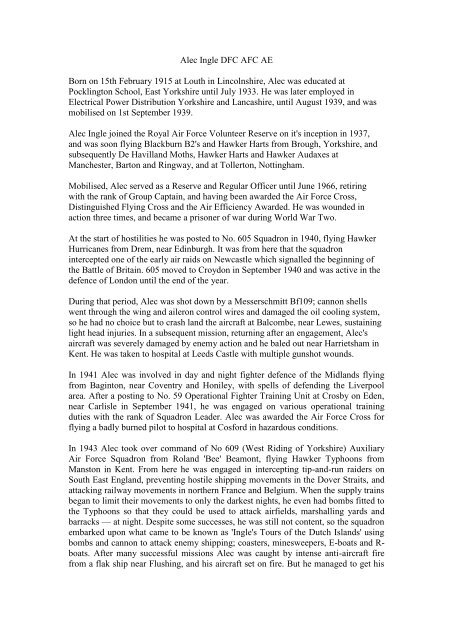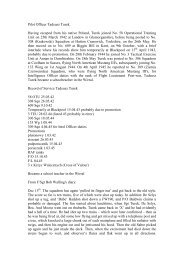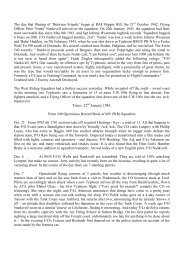Alec Ingle - 609 (West Riding) Squadron Royal Auxiliary Air Force
Alec Ingle - 609 (West Riding) Squadron Royal Auxiliary Air Force
Alec Ingle - 609 (West Riding) Squadron Royal Auxiliary Air Force
Create successful ePaper yourself
Turn your PDF publications into a flip-book with our unique Google optimized e-Paper software.
<strong>Alec</strong> <strong>Ingle</strong> DFC AFC AE<br />
Born on 15th February 1915 at Louth in Lincolnshire, <strong>Alec</strong> was educated at<br />
Pocklington School, East Yorkshire until July 1933. He was later employed in<br />
Electrical Power Distribution Yorkshire and Lancashire, until August 1939, and was<br />
mobilised on 1st September 1939.<br />
<strong>Alec</strong> <strong>Ingle</strong> joined the <strong>Royal</strong> <strong>Air</strong> <strong>Force</strong> Volunteer Reserve on it's inception in 1937,<br />
and was soon flying Blackburn B2's and Hawker Harts from Brough, Yorkshire, and<br />
subsequently De Havilland Moths, Hawker Harts and Hawker Audaxes at<br />
Manchester, Barton and Ringway, and at Tollerton, Nottingham.<br />
Mobilised, <strong>Alec</strong> served as a Reserve and Regular Officer until June 1966, retiring<br />
with the rank of Group Captain, and having been awarded the <strong>Air</strong> <strong>Force</strong> Cross,<br />
Distinguished Flying Cross and the <strong>Air</strong> Efficiency Awarded. He was wounded in<br />
action three times, and became a prisoner of war during World War Two.<br />
At the start of hostilities he was posted to No. 605 <strong>Squadron</strong> in 1940, flying Hawker<br />
Hurricanes from Drem, near Edinburgh. It was from here that the squadron<br />
intercepted one of the early air raids on Newcastle which signalled the beginning of<br />
the Battle of Britain. 605 moved to Croydon in September 1940 and was active in the<br />
defence of London until the end of the year.<br />
During that period, <strong>Alec</strong> was shot down by a Messerschmitt Bf109; cannon shells<br />
went through the wing and aileron control wires and damaged the oil cooling system,<br />
so he had no choice but to crash land the aircraft at Balcombe, near Lewes, sustaining<br />
light head injuries. In a subsequent mission, returning after an engagement, <strong>Alec</strong>'s<br />
aircraft was severely damaged by enemy action and he baled out near Harrietsham in<br />
Kent. He was taken to hospital at Leeds Castle with multiple gunshot wounds.<br />
In 1941 <strong>Alec</strong> was involved in day and night fighter defence of the Midlands flying<br />
from Baginton, near Coventry and Honiley, with spells of defending the Liverpool<br />
area. After a posting to No. 59 Operational Fighter Training Unit at Crosby on Eden,<br />
near Carlisle in September 1941, he was engaged on various operational training<br />
duties with the rank of <strong>Squadron</strong> Leader. <strong>Alec</strong> was awarded the <strong>Air</strong> <strong>Force</strong> Cross for<br />
flying a badly burned pilot to hospital at Cosford in hazardous conditions.<br />
In 1943 <strong>Alec</strong> took over command of No <strong>609</strong> (<strong>West</strong> <strong>Riding</strong> of Yorkshire) <strong>Auxiliary</strong><br />
<strong>Air</strong> <strong>Force</strong> <strong>Squadron</strong> from Roland 'Bee' Beamont, flying Hawker Typhoons from<br />
Manston in Kent. From here he was engaged in intercepting tip-and-run raiders on<br />
South East England, preventing hostile shipping movements in the Dover Straits, and<br />
attacking railway movements in northern France and Belgium. When the supply trains<br />
began to limit their movements to only the darkest nights, he even had bombs fitted to<br />
the Typhoons so that they could be used to attack airfields, marshalling yards and<br />
barracks — at night. Despite some successes, he was still not content, so the squadron<br />
embarked upon what came to be known as '<strong>Ingle</strong>'s Tours of the Dutch Islands' using<br />
bombs and cannon to attack enemy shipping; coasters, minesweepers, E-boats and Rboats.<br />
After many successful missions <strong>Alec</strong> was caught by intense anti-aircraft fire<br />
from a flak ship near Flushing, and his aircraft set on fire. But he managed to get his
aircraft and the <strong>Squadron</strong> back to base at Manston. He then was awarded the<br />
Distinguished Flying Cross.<br />
Manston was at that time one of the busiest airfields in the country, with many<br />
different aircraft landing at all times of the day and night At 03.30 one morning, <strong>Alec</strong><br />
was surprised to see a Focke Wulf Fw190 landing, but thinking quickly, he chased<br />
after it in the squadron car and, not being armed, arrested the pilot, Heinz Ehrhardt, by<br />
pointing his finger at him! The unfortunate pilot had mistaken the Thames estuary for<br />
the Channel, and thought he was landing at St Omer.<br />
After a very active day and night spell, the <strong>Squadron</strong> moved to Matlask in Norfolk, to<br />
continue attacks against the shipping bringing German supplies from Sweden to<br />
Holland, and acting as an escort for US <strong>Air</strong> <strong>Force</strong> Bombers crossing the coast on their<br />
way home. Following this the <strong>Squadron</strong> moved to Lympe in Kent, and continued<br />
attacks on French communications. In the summer of 1943 <strong>Alec</strong> was promoted to<br />
Wing Commander and took command of No.124 Wing, which consisted of three large<br />
squadrons of Typhoon fighter bombers and the wing attacked airfields, coastal<br />
defences and communications in Northern France.<br />
<strong>Alec</strong> was shot down on 11th September 1943 whilst attacking a German airfield at<br />
Beauvais-Tille near Paris. He was in combat with two FwI9Os when his aircraft went<br />
out of control, trapping him inside until it finally blew up at approximately 300 ft (90<br />
metres) flinging him out. Thankfully he managed to open his parachute just before<br />
hitting the ground, but the explosion burned his face and legs. Despite his injuries he<br />
managed to hide from pursuing German troops and dogs until nightfall, when he<br />
located a farm and took refuge in the straw barn. The following day he was found by a<br />
terrified farmer whose wife provided some food and sought assistance from local<br />
agents. The priest arrived and administered extreme unction, but the agent indicated<br />
that there were no French doctors nearby, so he was carried to the local hospital in<br />
Aumale by cart. The Germans then took over and they had to spend several hours<br />
picking wheat husks out of his badly burned face and legs. He was moved by<br />
ambulance to the Luftwaffe base at Poix, and hence to hospital in Amiens. After some<br />
time in hospital <strong>Alec</strong> was taken by train, on a stretcher to Paris and then to Hohemark,<br />
near Frankfurt. This hospital was used for interrogation purposes as an adjunct to the<br />
interrogation camp, Dulag Luft, which was dose by at Ober Ursel. <strong>Alec</strong> was able to<br />
communicate the detail of his survival to his old squadron by sending a postcard with<br />
the rather cryptic message “Irvin beat Newton by two seconds!”<br />
After some weeks <strong>Alec</strong> was moved to Dulag Luft where about 40 British and 80<br />
American aircrew were assembled, and they were loaded into three cattle trucks for a<br />
long and cold three day journey to Stalag Luft 3 at Sagan. They joined about 1,000<br />
prisoners in North Camp where the tunneling operations were in progress, which led<br />
to 'The Great Escape'. Just six weeks before the tunnel broke successfully from North<br />
Camp (sadly resulting in some 50 prisoners being executed by the Gestapo), <strong>Alec</strong> was<br />
moved to a subsidiary camp at Belaria, where he was eventually joined by Roland<br />
“Bee” Beamont, greeting him with “What’s kept you so long Bee-we’ve been<br />
expecting you!”<br />
After Christmas 1944, as the Russians approached they were moved out of Belaria,<br />
and trudged through the snow for a week, heading west until housed in a camp for
French workers at Luckenwalde, near Juterbog, some 35 miles south of Berlin. The<br />
conditions were appalling, and the rations were at starvation levels, with some 25,000<br />
prisoners and forced workers of varying nationalities. As the Russians approached<br />
Berlin, the Germans attempted to move the RAF <strong>Air</strong>crew to Austria, but<br />
communications were cut by the advancing allies. The German Commandant had an<br />
order signed by Himmler not to allow RAF <strong>Air</strong>crew to fall into Russian hands but,<br />
after negotiations, he did not execute the order, and eventually handed the whole<br />
camp over to the RAF contingent who had already made plans to deal with this<br />
eventuality. <strong>Alec</strong> then became Camp Administrator, and subsequently Russian<br />
Liaison Officer.<br />
The Russians appeared in due course, but then left the camp to its own devices.<br />
Foraging parties were sent out, and transport was acquired in the attempt to keep the<br />
remaining 20,000 remaining prisoners fed. The appointment of a Russian camp<br />
commandant helped very little, especially as refugees kept flooding in at the sight of<br />
the British flag. The Russians resisted several attempts by the Americans, who were<br />
on the Elbe some 35 miles away, to remove the Anglo-American prisoners, but after<br />
some weeks, the allied prisoners were trucked to the Elbe, where they where picked<br />
up, taken to the airfield at Halle Leizig, and flown back to the UK.<br />
After a few weeks leave following repatriation, <strong>Alec</strong> was posted back to Fighter<br />
Command to take command of the airfield at <strong>West</strong> Malling in Kent. Later he took<br />
command of RAF Tangmere for a few months, then Pembrey in Wales, and Chivenor<br />
in Devon before attending the RAF Staff College at Bracknell. On graduation from<br />
Staff College he spent a period on the directing staff of the Officers Advanced<br />
Training School, before moving to Tangmere once again as the Wing Commander<br />
Administration. In 1952 he was posted to Holland to command the RAF station at<br />
Eindhoven, with the 2nd Tactical <strong>Air</strong> <strong>Force</strong>, and following this, in 1955, to<br />
Greenwich on the directing staff of the RN Staff College.<br />
In 1958, <strong>Alec</strong> moved to Singapore as Deputy Head of the Far East Defence<br />
Secretariat, which involved travelling around the Pacific, Hong Kong, Tokyo, Pearl<br />
Harbor, North Borne, Sarawak and Malaysia. This was followed by a year on<br />
intelligence work in Whitehall and then by five years as Deputy Director of <strong>Air</strong> Staff<br />
Plans and Policies in the <strong>Air</strong> Ministry / Ministry of Defence, principally engaged in<br />
the matters related to the size and shape of the RAF. During this time he was one of<br />
the 13 Battle of Britain pilots to head the funeral procession of Sir Winston Churchill.<br />
There were 2,947 of them. Four hundred and seventy-seven died in the 113 days<br />
before it was over. Another 802 died in the years and battles that followed. Others<br />
were shot down, maimed, disfigured, wounded, burnt, captured. They were the Few -<br />
the handful of fighter pilots who won the Battle of Britain - and saved Britain. The<br />
men more deeply associated than any others with the Churchill legend. 13 of them<br />
marched at the head of Sir Winston’s funeral, <strong>Alec</strong> <strong>Ingle</strong> was one of them, seen in a<br />
contemporary photograph with the others standing second from the right. A proffered<br />
post as <strong>Air</strong> Advisor to the High Commissioner in New Delhi was rejected in favour of<br />
retirement in 1966.<br />
After the war <strong>Alec</strong> became a keen sailor, and he owned a variety of sailing yachts, the<br />
last of which was a 40’ Finisterre class yawl which he had built in Hong Kong during<br />
the Singapore posting. His knowledge of boats and their operation was extensive, he
made many voyages throughout European waters, and was a member of the Cruising<br />
Club. On changing to motor sailing yachts, he started a yacht sales business and<br />
acquired a small boat yard in Littlehampton. The business developed the building of<br />
the Banjer and Rogger range of Dutch designed motorsailers, but unfortunately this<br />
venture failed, as so many others did in the late 70’s, due to the recession and high<br />
inflation. However <strong>Alec</strong> retained close contact with Littlehampton through<br />
membership of the Littlehampton Harbour Board, of which he was Chairman for nine<br />
years.<br />
<strong>Alec</strong>’s election as an Arun District Councillor in 1979 resulted in his appointment as<br />
Vice Chairman of the planning and development committee, and the Chairmanship<br />
the following year. This was followed by the Chairmanship of the finance Sub<br />
Committee in 1982 and the Vice Chairmanship of policy and resources, together with<br />
the leadership of the ruling Conservative group. On re-election the following year, he<br />
was Chairman of the Policy and Resources Committee, and leader of the Council. In<br />
1986 <strong>Alec</strong> became Chairman of the Planning Committee, Vice Chairman of the<br />
Policy Committee, and Deputy Leader of the Conservative Group. He did not seek reelection<br />
in 1987, but was Chairman of the Arundel Constituency Conservative<br />
Association from 1991 until 1994.<br />
<strong>Alec</strong>'s first marriage in 1939 to Joan Bates was dissolved. He was survived by his<br />
second wife, Frances Mary McLean, eldest daughter of Sir William Hannah McLean,<br />
who was Conservative Member of Parliament for the Tredeston Division in Glasgow<br />
1931-1935, after serving in the Egyptian ministry of the Interior as Engineer-in-Chief.<br />
<strong>Squadron</strong> Leader A <strong>Ingle</strong> DFC AFC<br />
<strong>Alec</strong> <strong>Ingle</strong> was born on Feb 8th 1916 and joined the RAFVR at the age of 21. After<br />
training at Brough and No 14 FTS at Kinloss, he was commissioned and posted to 605<br />
<strong>Squadron</strong>, then at Drem in East Lothian in 1940. By November he had been promoted<br />
to Flight Commander and had been shot down three times. In July 1941 he was posted<br />
to 59 OTU as an instructor where he received the AFC and promoted to <strong>Squadron</strong><br />
Leader. On the 5th May 1943 he was posted to the command of <strong>609</strong>(WR) <strong>Squadron</strong><br />
where he led the squadron on anti-shipping strikes in their Typhoons. To the pilots of<br />
the squadron, these strikes became known as "<strong>Ingle</strong>s tour of theDutch Islands". By<br />
August he had been promoted to Wing Commander and posted to command No 124<br />
Wing. On the 11th of Sepember 1943 he was in combat with Fw190's when his<br />
aircraft blew up. As his aircraft disintegrated around him, he managed to get out at an<br />
altitude of around 300 feet. Fortunately his parachute opened up just in time and was<br />
captured on landing and taken to Stalag Luft III where he remained for the rest of the<br />
war. He remained in the RAF after repatriation and retired as a Group Captain in<br />
1966.<br />
INGLE, <strong>Alec</strong>, flew with 605 <strong>Squadron</strong> as a Flying Officer during the Battle of<br />
Britain. On 8th September 1940 he probably destroyed a Do17 and on 12th October<br />
shot down a Bf109. He claimed Bf109's probably destroyed on the 26th and the 27th,<br />
and damaged one on 8th November. On 11th November he destroyed a Bf109, and by<br />
the end of the year his score was 3. He had been shot down three times himself, and<br />
wounded once. Early in 1941 he served in 124 <strong>Squadron</strong>, but in July was posted to 74<br />
<strong>Squadron</strong>. In 1943 he commanded <strong>609</strong> <strong>Squadron</strong> on Typhoons, and damaged 15 ships
while with the unit. He was promoted to Wing Commander in August 1943, and by<br />
the end of the war had received the DFC and AFC, with a score of 5.





